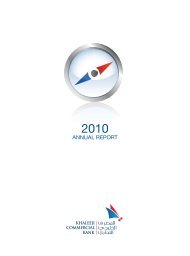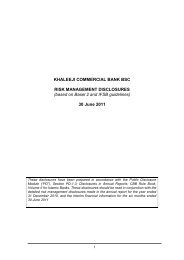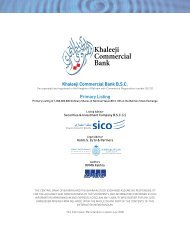2011 Annual Report - Khaleeji Commercial Bank BSC
2011 Annual Report - Khaleeji Commercial Bank BSC
2011 Annual Report - Khaleeji Commercial Bank BSC
Create successful ePaper yourself
Turn your PDF publications into a flip-book with our unique Google optimized e-Paper software.
KHALEEJI COMMERCIAL BANK <strong>BSC</strong><br />
NOTES TO THE CONSOLIDATED FINANCIAL STATEMENTS<br />
for the year ended 31 December <strong>2011</strong><br />
31. RISK MANAGEMENT<br />
Introduction and overview<br />
The Group has exposure to the following risks from its use of financial instruments:<br />
• credit risk<br />
• liquidity risk<br />
• market risks<br />
• operational risks<br />
This note presents information about the Group’s exposure to each of the above risks, it’s objectives, policies and processes<br />
for measuring and managing risk, and the <strong>Bank</strong>’s management of capital.<br />
Risk management framework<br />
The Board of Directors has overall responsibility for the establishment and oversight of the <strong>Bank</strong>’s risk management framework.<br />
The Board has established an Executive Risk Management Committee, which is responsible for developing and monitoring the<br />
<strong>Bank</strong>’s risk management policies in the specified areas. The committee also continuously monitors consistent implementation<br />
of the Board approved policies in the <strong>Bank</strong> and reports deviations, if any, to the Board. The committee consists of heads of<br />
business and other functional units in the <strong>Bank</strong> and reports regularly to the Risk Management Committee of the Board.<br />
The <strong>Bank</strong>’s risk management policies are established to identify and analyse the risks faced by the <strong>Bank</strong>, to set appropriate risk<br />
limits and controls, and to monitor risks and adherence to limits. Risk management policies and systems are reviewed regularly to<br />
reflect changes in market conditions, products and services offered. The <strong>Bank</strong>, through its training and management standards and<br />
procedures, aims to develop a disciplined and constructive control environment, in which all employees understand their roles<br />
and obligations.<br />
The <strong>Bank</strong>’s Audit Committee is responsible for monitoring compliance with the risk management policies and procedures, and<br />
for reviewing the adequacy of the risk management framework in relation to the risks faced by the <strong>Bank</strong>. The Audit Committee<br />
is assisted in these functions by Internal Audit. Internal Audit undertakes both regular and ad-hoc reviews of risk management<br />
controls and procedures, the results of which are reported to the Audit Committee.<br />
Credit Risk<br />
Credit risk is the risk of financial loss to the <strong>Bank</strong> if a customer or counterparty to a financial instrument fails to meet its<br />
contractual obligations, and arises principally from the <strong>Bank</strong>’s exposures to placements with financial institutions, financing<br />
assets, outstanding assets acquired for leasing, investment in sukuk and receivables classified under other assets. For risk<br />
management reporting purposes, the <strong>Bank</strong> considers and consolidates all elements of credit risk exposure (such as individual<br />
and group exposure risk, country and sector concentration risk, related party exposure, etc.). The <strong>Bank</strong> monitors the total<br />
exposure to assets acquired for leasing (including lease rentals receivable) on a cumulative basis for monitoring of market risk<br />
and credit risk.<br />
The Board of Directors has delegated responsibility for the management of credit risk to its Executive Risk Management<br />
Committee (ERMC). A separate Risk and Credit Management Department (RMD), reporting to the ERMC is responsible for<br />
oversight of the <strong>Bank</strong>’s credit risk, including:<br />
• Formulating credit policies in consultation with business units, covering collateral requirements, credit assessment, risk<br />
grading and reporting, documentary and legal procedures, and compliance with regulatory and statutory requirements and<br />
submitting the same for approval to the Board of Directors.<br />
• Establishing the authorisation structure for the approval and renewal of credit facilities. Authorisation limits are not at present<br />
allocated to business units. Smaller exposures are approved by the Executive Credit & Investment Committee consisting<br />
of heads of business units and the Chief Operating Officer. Larger facilities require approval by the Chief Executive Officer,<br />
Chairman, Board Investment and Credit Committee or the full Board, as the case may be.<br />
• Reviewing and assessing credit risk. RMD assesses all credit exposures and signs off on the relevant proposals prior to<br />
approval of the facilities by the appropriate authorities. Renewal and review of facilities are subject to the same process.<br />
68<br />
<strong>Annual</strong> <strong>Report</strong> <strong>2011</strong>










